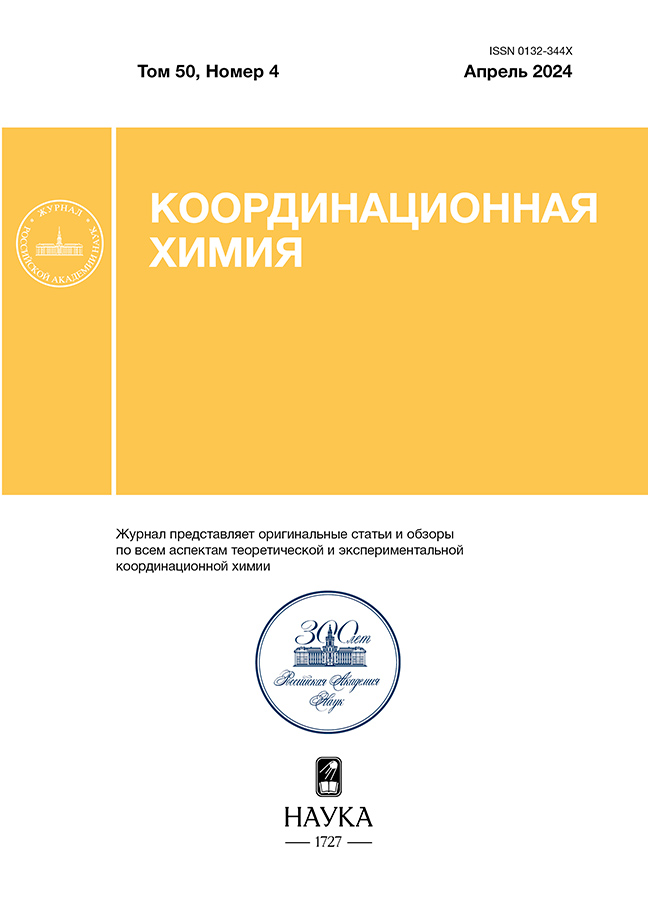Alkyltriphenylphosphonium Arenesulfonates: Synthesis and Structures
- 作者: Sharutin V.V.1, Sharutina O.K.1, Mekhanoshina E.S.1
-
隶属关系:
- South Ural State University (National Research University)
- 期: 卷 50, 编号 4 (2024)
- 页面: 278-284
- 栏目: Articles
- URL: https://rjonco.com/0132-344X/article/view/667608
- DOI: https://doi.org/10.31857/S0132344X24040063
- EDN: https://elibrary.ru/NPFWFA
- ID: 667608
如何引用文章
详细
The reactions of equimolar amounts of alkyltriphenylphosphonium bromide with arenesulfonic acids in an aqueous-acetone solution afford alkyltriphenylphosphonium arenesulfonates [Ph3PCH2ОMe][OSO2C6H3(OH-4)(COOH-3)] (I), [Ph3PCH2СN][OSO2C6H4(COOH)-2] (II), [Ph3PCH2C(O)Me][OSO2С6H4(COOH-2] (III), and [Ph3PCH2C(O)Me][OSO2Naft-1] (IV). According to the X-ray diffraction (XRD) data, the crystals of compounds I−IV have ionic structures with tetrahedral alkyltriphenylphosphonium cations (P−С 1.7820(19)−1.8330(20) A, CPC 05.37(10)°−112.09(12)°) and arenesulfonate anions. The crystal of compound I contains hydrogen bonds (S=O∙∙∙H−OC(O) 1.87 A) linking the arenesulfonate anions into chains. The structural organization of the crystals of compounds I−IV is mainly formed due to numerous weak hydrogen bonds between the cations and anions, for instance, S=O∙∙∙H−Car (2.29−2.70 A), C=O∙∙∙H–C (2.48 and 2.59 A), and N∙∙∙H–C (2.62−2.68 A).
全文:
作者简介
V. Sharutin
South Ural State University (National Research University)
编辑信件的主要联系方式.
Email: sharutin50@mail.ru
俄罗斯联邦, Chelyabinsk
O. Sharutina
South Ural State University (National Research University)
Email: sharutin50@mail.ru
俄罗斯联邦, Chelyabinsk
E. Mekhanoshina
South Ural State University (National Research University)
Email: sharutin50@mail.ru
俄罗斯联邦, Chelyabinsk
参考
- The Chemistry of Organophosphorus Compounds, Hartley, F.R., Ed., New York: Wiley, 1983, vol. 3.
- Moritz, R., Wagner, M., Schollmeyer, D., et al., Chem.-Eur. J., 2015, vol. 21, p. 9119. https://doi.org/10.1002/chem.201406370
- Werner, T., Adv. Synth. Catal., 2009, vol. 351, p. 1469. https://doi.org/10.1002/adsc.200900211
- Cordovilla, C., Bartolome, C., Martinez-Ilarduya, J.M., et al., ACS Catal., 2015, vol. 5, p. 3040. https://doi.org/10.1021/acscatal.5b00448
- Chong, C.C., Hirao, H., and Kinjo, R., Angew. Chem., Int. Ed. Engl., 2015, vol. 127, p. 192. https://doi.org/10.1002/ange.201408760
- Luiz, J.F. and Spikes, H., Tribology Lett., 2020, vol. 68, p. 75. https://doi.org/10.1007/s11249-020-01315-8
- Zhu, Ch.-L., Zhang, F.-G., Meng, W., et al., Angew. Chem., Int. Ed. Engl., 2011, vol. 50, p. 5869. https://doi.org/10.1002/anie.201100283
- Cassity, C.G., Mirjafari, A., Mobarrez, N., et al., Chem. Commun., 2013, vol. 49, no. 69, p. 7590. https://doi.org/10.1039/c3cc44118k
- Canac, Y., Duhayon, C., and Chauvin, R., Angew. Chem., Int. Ed. Engl., 2007, vol. 46, p. 6313. https://doi.org/10.1002/anie.200701490
- Milenkovic, M., Warzajtis, B., Rychlewska, U., et al., Molecules, 2012, vol. 17, no. 3, p. 2567. https://doi.org/10.3390/molecules17032567
- Pavlova, J.A., Khairullina, Z.Z., Tereshchenkov, A.G., et al., Antibiotics, 2021, vol. 10, p. 489. https://doi.org/10.3390/antibiotics10050489
- Tsepaeva, O.V., Salikhova, T.I., Grigor′eva, L.R., et al., Med. Chem. Res., 2021, vol. 30, p. 925. https://doi.org/10.1007/s00044-020-02674-6
- Sodano, F., Rolando, B., Spyrakis, F., et al., ChemMedChem, 2018, vol. 13, p. 1238. https://doi.org/10.1002/cmdc.201800088
- Mironov, V.F., Nemtarev, A.V., Tsepaeva, O.V., et al., Molecules, 2021, vol. 26, p. 6350. https://doi.org/10.3390/molecules26216350
- Khasiyatullina, N.R., Gubaidullin, A.T., Shinkareva, A.M., et al., Russ. Chem. Bull., 2020, vol. 69, p. 2140. https://doi.org/10.1007/s11172-020-3012-3
- Romanov, S., Aksunova, A., Bakhtiyarova, Y., et al., J. Organomet. Chem., 2020, vol. 910, p. 121130. https://doi.org/10.1016/j.jorganchem.2020.121130
- Sharutin, V.V., Sharutina, O.K., and Mekhanoshina, E.S., Vest. YuUrGU. Ser. Khim., 2022, vol. 14, no. 2, p. 41.
- Sharutin, V.V., Sharutina, O.K., and Mekhanoshina, E.S., Russ. J. Gen. Chem., 2022, vol. 92, no. 6, p. 969.
- Sharutin, V.V., Sharutina, O.K., and Mekhanoshina, E.S., J. Struct. Chem., 2022, vol. 63, no. 10, p. 1629.
- Mekhanoshina, E.S., Vest. YuUrGU. Ser. Khim., 2023, vol. 15, no. 1, p. 31.
- Mekhanoshina, E.S., Vest. YuUrGU. Ser. Khim., 2023, vol. 15, no. 2, p. 55.
- Bruker. SMART and SAINT-Plus. Versions 5.0. Data Collection and Processing Software for the SMART System, Madison: Bruker AXS Inc., 1998.
- Bruker. SHELXTL/PC. Versions 5.10. An Integrated System for Solving, Refining and Displaying Crystal Structures from Diffraction Data, Madison: Bruker AXS Inc., 1998.
- Dolomanov, O.V., Bourhis, L.J., Gildea, R.J., et al., J. Appl. Cryst., 2009, vol. 42, p. 339. https://doi.org/10.1107/S0021889808042726
- Tarasevich, B.N., IK-spektry osnovnykh klassov organicheskikh soedinenii (IR Spectra of Main Classses of Organic Compounds), Tarasevich, B.N., Ed., Moscow: MGU, 2012.
- Infrakrasnaya spektroskopiya organicheskikh i prirodnykh soedinenii: ucheb. posobie (Infrared Spectroscopy of Organic and Natural Compounds. Study Guide), Vasil′ev, A.V., Grinenko, E.V., Shchukin, A.O., et al., Eds., St.-Petersburg: SPbGLTA, 2007.
补充文件














